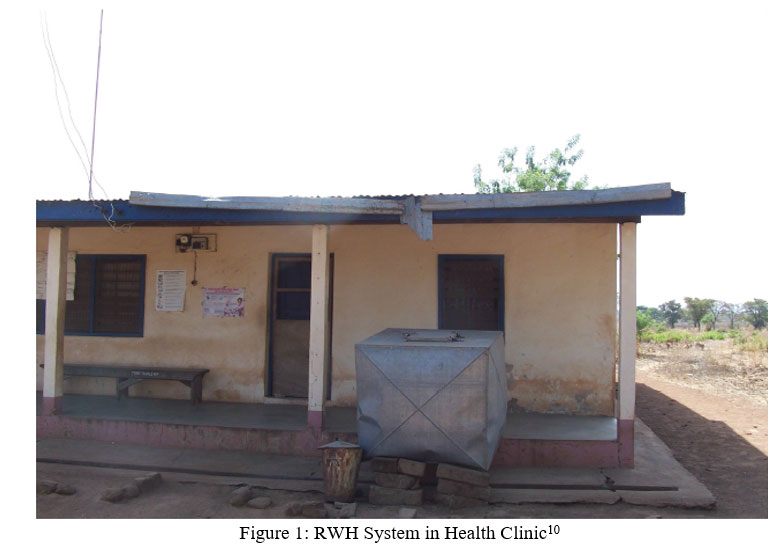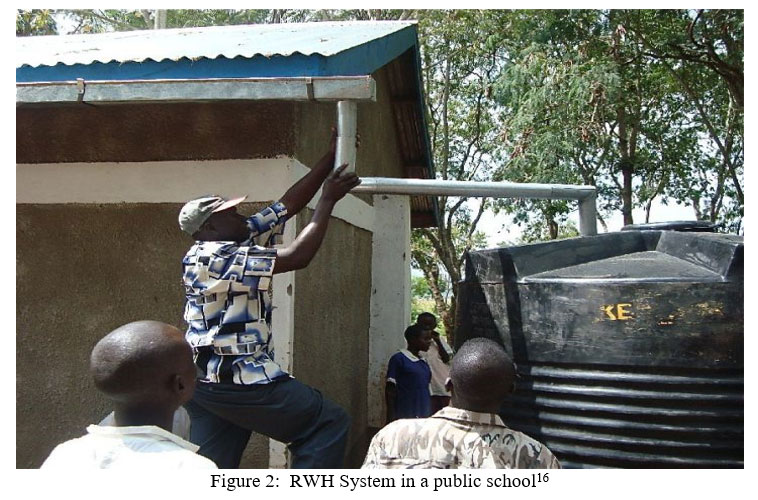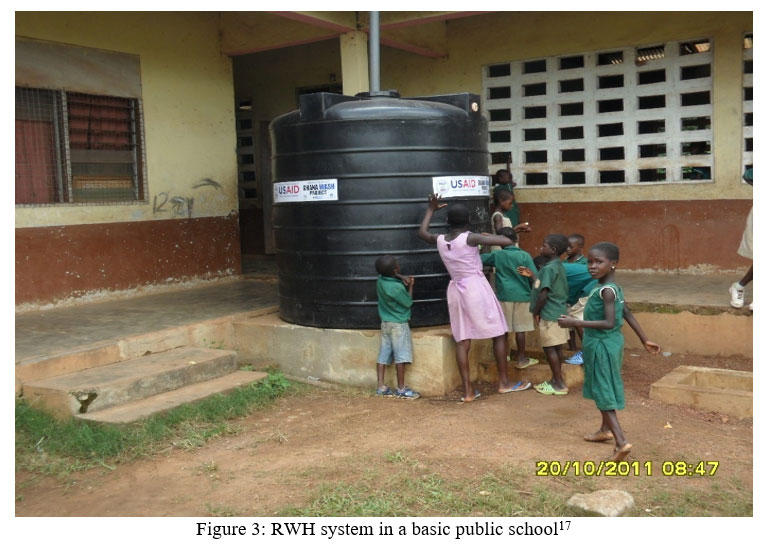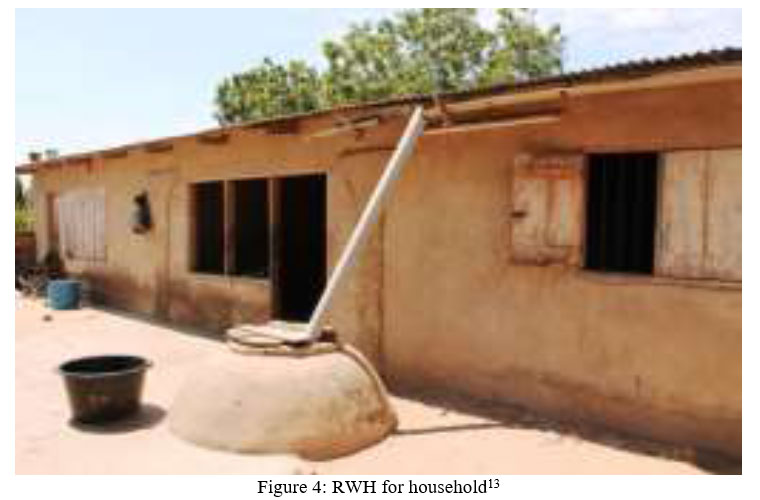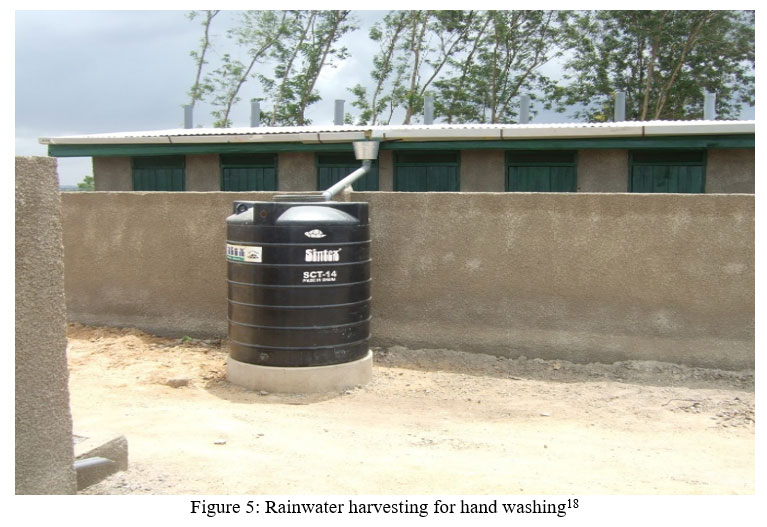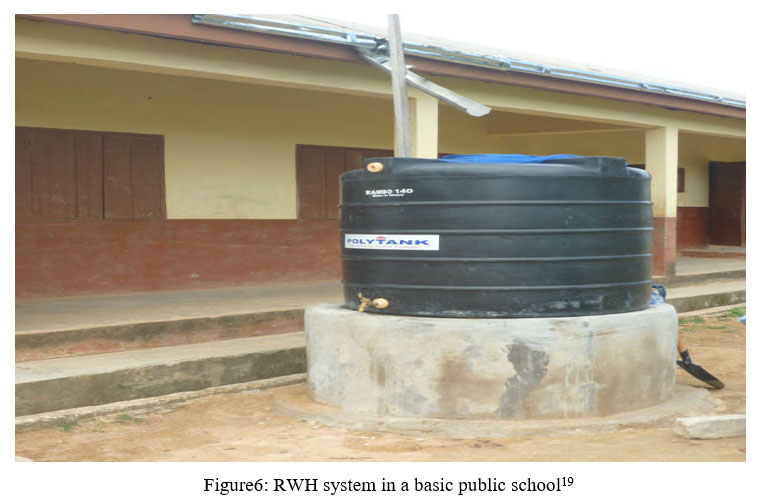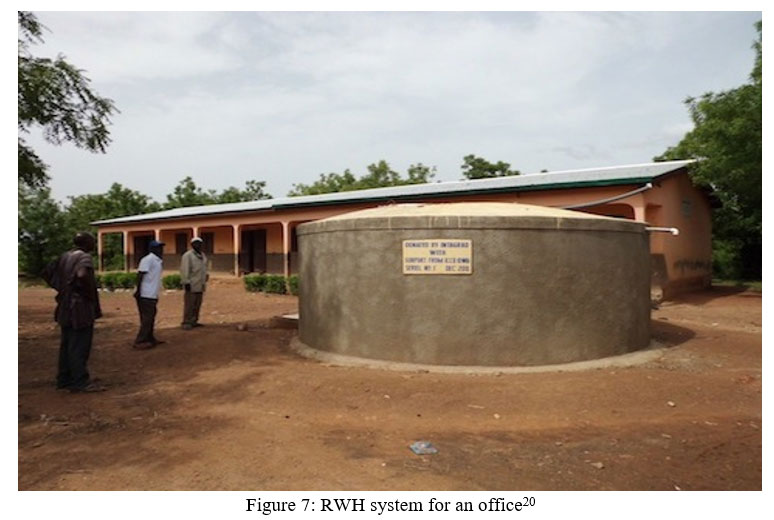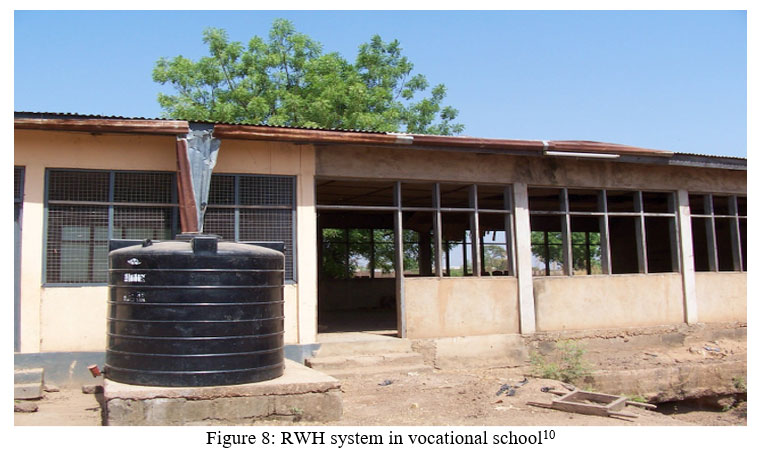Status of Rainwater Harvesting (RWH) in Ghana
DOI: http://dx.doi.org/10.12944/CWE.13.1.17
Copy the following to cite this article:
Andoh C, Gupta S, Khare D. Status of Rainwater Harvesting (RWH) in Ghana. Curr World Environ 2018;13(1). DOI:http://dx.doi.org/10.12944/CWE.13.1.17
Copy the following to cite this URL:
Andoh C, Gupta S, Khare D. Status of Rainwater Harvesting (RWH) in Ghana. Curr World Environ 2018;13(1). Available from: http://www.cwejournal.org?p=1070/
Download article (pdf)
Citation Manager
Publish History
Select type of program for download
| Endnote EndNote format (Mac & Win) | |
| Reference Manager Ris format (Win only) | |
| Procite Ris format (Win only) | |
| Medlars Format | |
| RefWorks Format RefWorks format (Mac & Win) | |
| BibTex Format BibTex format (Mac & Win) |
Article Publishing History
| Received: | 2017-09-04 |
|---|---|
| Accepted: | 2018-03-19 |
Introduction
Undeniably, all water resources be it a surface water source or groundwater, originates from rainfall and constitute the main sources of water for domestic, industrial and agricultural usage. Water scarcity and pollution problems have generated public discussions and concerns by both policy makers and researchers. This has led to several studies on the quality of groundwater and surface water in Ghana using conventional methods.1 Projections from United Nations, 2014, reveals that about 1.8 billion people of the world's population would be facing water availability problems by 2025. Increasing growth of populations, industrialization, intense irrigation coupled with global climate change is putting much pressure on available sources of water.2
Climate in Ghana is warm with a mean annual temperatures ranging 24°C to 36°C. In the southwest, the mean annual rainfall is maximum of about 2250mm, 1000mm in the north and 900mm in the southeast. Humidity on the coast is about 90% whilst during the dry season, humidity is about 20% in the north. Heavy rainfall occurs from about April through late June. The water scarcity condition occurs from November to January throughout the country.3
Rainwater harvesting is a technique used for the collection, conveying and storing of rainwater for domestic, industrial or agricultural use. This technology can either be direct collection or storage of the run-off rainwater for direct use in future. Rain water harvesting is a technology that seeks to harness surface and groundwater, prevent evaporation and seepage losses. In semi-arid parts of East Africa (e.g. Tanzania and Kenya), and in Burkina Faso of West Africa; RWH systems are widely practiced, however in Ghana the practice is different. It is rarely practiced in the institutions, even though it is known that RWH has been incorporated in many missionary and government residences during the colonial era.4
Rainwater harvesting in households of Ghana, involves the use of a small water storage containers of an average volume of 16 litres which are placed below the tips of roofs to receive water whenever there is rainfall. These storage containers catch rains as they fell and are transferred into main storage containers in their various houses mainly by women and children as these buckets become full.5 In other communities, residents rely on boreholes, unprotected streams, dams, rivers, dug-outs and impounded reservoirs for their domestic water demands. Few of these water sources serve as drinking places for animals as well, and the health risks posed by this are endless and far reaching. Harvesting of rainwater with roof-top has proven to be among the most growing domestic water resources.6
As of November 1, 2012, the Ghana WASH project initiated by USAID had provided several facilities including rainwater harvesting systems to various rural communities in Central, Western and the Greater Accra Regions.7 Various facilities provided are outlined in Table 1.
Table 1: Ghana WASH initiatives
|
Facility |
Proposed task |
Completed task |
Remained task |
|
Institutional KVIP, WC |
110 |
110 |
0 |
|
Wells |
33 |
33 |
0 |
|
Small Town Pipe Systems |
2 |
0 |
2 |
|
Rainwater Harvesting Systems |
32 |
31 |
1 |
|
Boreholes |
75 |
61 |
14 |
Rainwater harvesting technique has the capability to reduce dependency on public supply system, conserve water resources and subsequently save money for other developmental activities. To achieve these, this study seeks to present rainwater harvesting technique as an add-on to water supply in the Agona West Municipality specifically Agona Swedru.
Methodology
Description of area of research work
The study area is Agona Swedru and is the capital of Agona West Municipality, one of the cocoa growing areas in the country. The Agona West Municipality situated in the eastern corner of the Central Region of Ghana lies within latitudes 5030’ and 5050’N and between longitudes 0035’ and 0055’W8. As of 2013, the population of study area was 68,216 with a spanning area of 540 km².Swedru as simply called, can be located within the wet semi-equatorial climate zone. This area, having a bi-modal rainfall system, with maximum rainfall felt in May/June and September/October has an annual rainfall range of 1000mm - 1400mm. This situations puts this location into the forest zone, which allows for two main growing/wet seasons. The dry-seasons run from December to March with the highest mean monthly temperature of 33.80C being recorded between March/April. The lowest mean monthly temperature experienced often in the month of August is estimated as 29.40C.9
Rainwater harvesting
Rainwater harvesting is an act in which rainwater is harnessed, stored and utilized later for either domestic or agricultural purposes. The rainwater could be harvested from different locations, however the roof-top catchment systems are mostly adopted for supplies in homes.
Rainwater studies in Ghana
An assessment on the current state of rainwater harvesting in the Northern Region of Ghana suggested a form of treatment to be done on water harvested before consumption. It also outlined measures on how rainwater harvesting could be used to address Pure Home Water‘s goal of reaching one million people in the coming years.10 As per research work carried out on rainwater harvesting in the peri-urban areas of Accra such areas are suitable for the implementation of Domestic Rainwater Harvesting (DRWH), however it is only a complementary source to the water supplement in the area.11 A comprehensive research carried out on the chemical composition of rainwater in a mining community in Ghana (Obuasi) revealed that rain water in area was acidic i.e. (4.0 to 5.6). Anthropogenic activities in the area have strongly influenced the rainwater with Lead (Pb) found to be above the WHO permissible limit of 0.01mg/l as a potable water.12 As per a case study of central Gonja district in the Northern part of Ghana, rain water is suitable for the activities such as washing, bathing, cooking and drinking in the district.6 A research on Rainwater Harvesting in the Coastal Savanna regions of Ghana recommended that government intensifies its programmes and activities, including awareness campaigns and training of artisans at the local level to create renewed interest in the activity. It was also recommended that the available water resources, especially the major rivers be harnessed for irrigation. The research again recommended that manufacturing industry in Ghana takes up the challenge to produce RWH components for sale to the public.13 An assessment on physico-chemical and bacteriological parameters of rainwater in Adukrom- Akwapim, where there is heavy rainfall during the rainy seasons was carried out. Direct rainfall, stored rainwater and roof catchment rainwater were sampled and studied. The result showed a significant increase in physico-chemical and bacteriological parameter from the direct rainfall to roof catchment and the stored rainwater. They suggested treatment of water ought to be done before drinking.14 A research on chemical and isotopic composition of rainwater in the coastal, forest and mountainous parts of Volta region of Ghana recommended, harvesting of rain water and storing for domestic use because it came to bear that the physico-chemical parameters of rainwater was satisfactory.14 An assessment of rainwater harvesting as supplement to domestic water conducted in Kotei Ghana concluded that rainwater is suitable for either bathing or washing but not for drinking.15
In general, different kinds of rainwater harvesting systems are installed in Ghana. Small storage tanks are used to collect rainwater from different roof catchments. Some of the existing rainwater harvesting systems installed in Ghana are presented in Figures. 1 to 8. It can be seen that there is no understanding of filter presently. There are many important issues and challenges pertaining to rainwater harvesting in Ghana and have been discussed in this paper.
Results and Discussion
Rainwater harvesting techniques common in Ghanafig1
|
Figure 1: RWH System in Health Clinic10 |
|
|
Figure 2: RWH System in a public school16 |
|
|
Figure 3: RWH system in a basic public school17 |
|
|
Figure 4: RWH for household14 |
|
|
Figure 5: Rainwater harvesting for hand washing18 |
|
|
Figure 6: RWH system in a basic public school19 |
|
|
Figure 7: RWH system for an office20 |
|
|
Figure 8: RWH system in vocational school10 |
In Figure. 1, there is a 500L galvanized steel tank that serves water to an unknown number of people in the Pong Tamale Health clinic. It could be seen that filter was not incorporated in the design which puts the quality of water being used questionable.10 Figure. 2 presents a situation of the rainwater harvesting system being employed in a public school in Ghana. Again, filter is absent in the set up.16 An initiative by Ghana WASH project under the USAID can also be seen in Figure. 3 where the rainwater harvesting system has been established in a basic school to provide water to the young students. Installation of filter over here cannot be found.17 A household in a coastal area of the country where the storage tank of the rainwater harvesting system was made of concrete is shown in Figure. 4. The situation is not different from the already discussed. Filter was neglected in the design.13 Figure. 5 shows a latrine in Doblo Gonno in which rainwater harvesting system has been implemented, however the essence of filter was ignored in the set up.18 Figure. 6 is a rainwater harvesting system in a public school in Sefwi- Bonwire. The system is not an exception of those with filters absent.19 Intagrad also supported in the construction of a rainwater harvesting system for hand washing in Tamale. The absence of filter can also been seen in Figure. 7.20 Figure. 8 also shows a rainwater harvesting system in Pong Tamale Vocational School Boys Correctional Center. It is clear here as well that filter has been neglected in the design.10
Issues and challenges
The present section provides a description on different parameters and issues related to rainwater harvesting in Ghana. For the implementation of this scheme, the challenges are hereby discussed below.
Poor roofing materials
The catchment of a RWH method first receives the rainfall directly from the sky hence adequate attention is needed with regards to its composition. “Slates” or asbestos sheets and aluminum sheets are the mostly used roofing in Southern part of Ghana, however, thatch dominates as one moves to the Northern part. Generally, any roofing form is acceptable provided it is able to collect rainwater but for drinking purposes, waters collected from roofs of thatched and asbestos need proper treatment. Therefore, the suitability and choice of such roof types have to be demonstrated by proper study5.
In Figure. 1, there is a 500L galvanized steel tank that serves water to an unknown number of people in the Pong Tamale Health clinic. It could be seen that filter was not incorporated in the design which puts the quality of water being used questionable.10 Figure. 2 presents a situation of the rainwater harvesting system being employed in a public school in Ghana. Again, filter is absent in the set up.16 An initiative by Ghana WASH project under the USAID can also be seen in Figure. 3 where the rainwater harvesting system has been established in a basic school to provide water to the young students. Installation of filter over here cannot be found.17 A household in a coastal area of the country where the storage tank of the rainwater harvesting system was made of concrete is shown in Figure. 4. The situation is not different from the already discussed. Filter was neglected in the design.13 Figure. 5 shows a latrine in Doblo Gonno in which rainwater harvesting system has been implemented, however the essence of filter was ignored in the set up.18 Figure. 6 is a rainwater harvesting system in a public school in Sefwi- Bonwire. The system is not an exception of those with filters absent.19 Intagrad also supported in the construction of a rainwater harvesting system for hand washing in Tamale. The absence of filter can also been seen in Figure. 7.20 Figure. 8 also shows a rainwater harvesting system in Pong Tamale Vocational School Boys Correctional Center. It is clear here as well that filter has been neglected in the design.10
Issues and challenges
The present section provides a description on different parameters and issues related to rainwater harvesting in Ghana. For the implementation of this scheme, the challenges are hereby discussed below.
Poor roofing materials
The catchment of a RWH method first receives the rainfall directly from the sky hence adequate attention is needed with regards to its composition. “Slates” or asbestos sheets and aluminum sheets are the mostly used roofing in Southern part of Ghana, however, thatch dominates as one moves to the Northern part. Generally, any roofing form is acceptable provided it is able to collect rainwater but for drinking purposes, waters collected from roofs of thatched and asbestos need proper treatment. Therefore, the suitability and choice of such roof types have to be demonstrated by proper study5.
Inappropriate harvesting facilities
Few people use the poly-tank of reasonable sizes in their homes to store water due to the high cost incurred in the construction of bigger storage tanks. Most household use small containers to store harvest rainwater. Majority of these containers have small volumes to store sufficient water for longer days. Owing to this, substantial litres of rainwater gets lost to households and waste as run-off. In order to catch sufficient litres of water, provision of large underground or bigger storage tank on a raised platform ought to be made.5
Type of house occupancy
Occupants in rented houses, however seem not ready to pump money in RWH facilities, since such disbursements may tie them to their current accommodation longer than their future situations may permit. They rather prefer acquiring smaller and mobile storage facilities, usually plastic containers for water storage.5
Inaccurate land boundaries
Having knowledge of one's land boundary is very essential to households having the power to engage in any constructional activities one their land without the fear troubles from land authorities and also encroachment. However, improper land demarcation is a major issue in some communities in Ghana. This situation creates problems among land owners in a particular locality thereby making it uneasy to delineate areas where storage facilities should be sited. Proper land boundary demarcation is therefore a must to avoid land disputes and to expedite the process if large scale rainwater harvesting is to be adopted.5
Quality of water
Recent developments reveals that rainwater in general rainwater is potable however, its quality usually gets affected by contaminations on the catchment and in the storage tank. Rainwater collects other contaminating materials that settle on the roofs. These include birds and lizards' excretions, falling plant debris from nearby trees, dust and any other foreign material found on roofs. Hence, installation of a filter is essential in RWH system.5
Uneven rainfall pattern
Unstable rainwater supply due to climatic change makes it difficult for one to initiate such project since he/she is unsure as to whether there would be regular rains during rainy days or not. Drying of spells coupled with droughts for longer periods could result serious problems in water supply.5
Conclusion and Recommendation
Rainwater harvesting widely is regarded as one of the best methods to harness water for future usage in this era of increasing water availability challenges, as per several studies. It is also evident from various research works that the use of filter in rainwater harvesting is absent in most communities in Ghana hence this paper seeks to come up with recommendation of a filter which should be cheap, easy to assemble and very effective to be adopted. It is also an undeniable fact that in adopting rainwater harvesting, some revenue could be saved as well. It is therefore concluded that rainwater could be harvested to supplement the water needs of residents of Agona west municipality and Ghana at large with respect to bathing and washing.
It is also recommended that the awareness of Rainwater harvesting be intensified to gain the acceptance and adoption of most people. Implementation of rainwater harvesting, will reduce the public water supply dependency and lessen the burden of utility bills which most people complain about. Rapid sand filters should however be incorporated in the design in most communities in Ghana since there is correlation between water quality and the surrounding environment.
Acknowledgement
The authors are highly grateful to the Department of Water Resources Development and Management, Indian Institute of Technology Roorkee for providing the required funding sources to carry out the current study smoothly.
References
-
Kortatsi, B. K. Concentration of trace metals in boreholes in the Ankobra Basin West African. J Appl Ecol. 2006;10(1942):73-87:2.
-
Lee, K.E., Mokhtar, M., Mohd Hanafiah, M., Abdul Halim, A., &Badusah, J. Rainwater harvesting as an alternative water resource in Malaysia: Potential, policies and development. J Clean Prod. 2016;126:218-222. doi:10.1016/j.jclepro.2016.03.060.
CrossRef -
Ministry of Local Government and Rural. National Environmental Sanitation Strategy and Action Plan, Materials in Transition. Gov Ghana. 2010;165.
-
Ltd H-ES. Republic of Ghana ,Ministry of Water Resources Works and Housing. Natl RAINWATER Harvest Strateg Final Rep. 2011;1:1-45.
-
Opare, S. Rainwater harvesting: An option for sustainable rural water supply in Ghana. GeoJournal. 2012;77(5):695-705. doi:10.1007/s10708-011-9418-6.
CrossRef -
Issaka, Z. Appropriate Rainwater Harvesting and DomesticWater Quality: A Case Study of Central Gonja District. 2011;142.
-
Agreement C. Ghana Water , Sanitation , and Hygiene ( Wash ) Project. 2013;1-52.
-
Report AP. AGONA WEST MUNICIPAL ASSEMBLY 2015 ANNUAL PROGRESS REPORT ( APR ). 2016.
-
Osei, C. Evaluating Post-Flood Disaster Response Strategies In Ashaiman And Agona Swedru. 2013;9-38.
-
Barnes, D. A. Assessment of Rainwater Harvesting In Northern Ghana. 2009;101.
-
Lundgren, A.,& Akerberg, H. Rainwater harvesting in the peri-urban areas of Accra: Status and prospects. Dep Geogr Resour Dev. 2006;75.
-
Akoto, O., Darko, G., &Nkansah, M. A. Chemical composition of rainwater over a mining area in Ghana. Int J Environ Res. 2011;5(4):847-854. doi:10.1021/es2035762.
CrossRef -
Project E. Clement Dorm-Adzobu Rainwater Harvesting in the Coastal Savanna Region of Ghana. 2012;(104).
-
Sitsofe Kretchy, M. Chemical and Isotopic Composition of Rainwater in the Coastal, Forest and Mountainous Areas of Volta Region of Ghana. 2014.
-
Awuah, E., Gyasi, S.F., Anipa, H. M. K., &Sekyiamah, K. E. Assessment of rainwater harvesting as a supplement to domestic water supply: Case study in Kotei-Ghana. Int Res J Public Environ Heal. 2014;1(6):126-131.
-
obed4washadvocacy. Rainwater Harvesting; a Viable Technology Option to Salvage Water Crisis in Ghana — obed4washadvocacy – obed4washadvocacy. https://obed4washadvocacy.wordpress.com/2016/04/11/rainwater-harvesting-a-viable-technology-option-to-salvage-water-crisis-in-ghana-obed4washadvocacy/.[ Accessed February 9, 2018].
-
Ghana Wash. Rainwater Harvesting «â€¯GHANA WASH PROJECT. http://ghanawashproject.org/water/rainwater-harvesting/.[ Accessed February 9, 2018].
-
worldclass-ghana.org. Project pictures. http://www.worldclass-ghana.org/photos.html. [Accessed February 9, 2018].
-
Water charity. Conclusion of Sefwi-Bonwire School Rainwater Harvesting Project - Ghana | Water Charity. https://watercharity.com/conclusion-sefwi-bonwire-school-rainwater-harvesting-project-ghana. [Accessed February 9, 2018].
-
Roverts, L. Training Akvo RSR users in Ghana - Akvo Foundation. http://akvo.org/blog/training-akvo-rsr-users-in-ghana/. Published 2012. [Accessed February 9, 2018].



